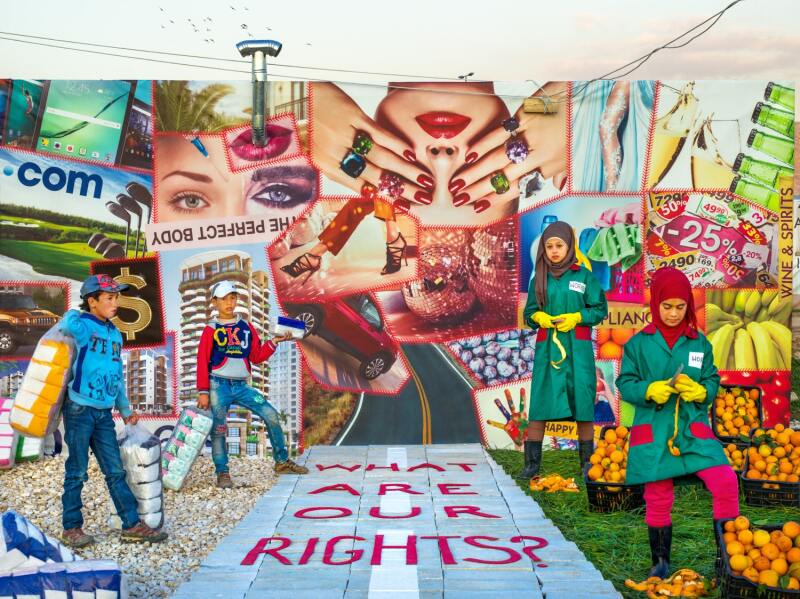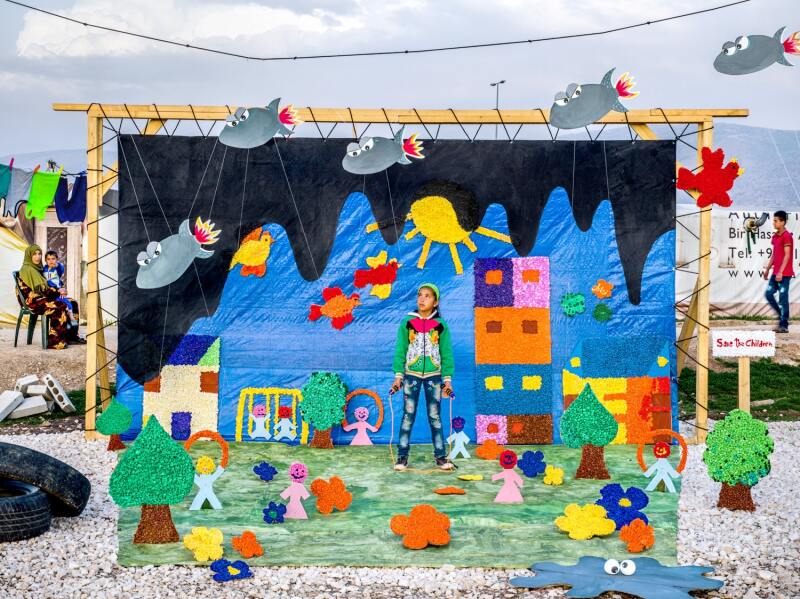“All the images out there of refugee kids are the same,” says photographer Patrick Willocq. “Google it, and you’ll find so many photos of dirty, crying kids. I wanted to break away from that and give them back their dignity.”
Last year, Willocq visited refugee camps in Tanzania and Lebanon on assignment for Save the Children, the humanitarian group. First, Willocq spent five days in each camp playing with the kids, coloring, and talking about life in the camps, their lives back home, and their dreams for the future. Then, Willocq and his team returned to each settlement for 12-day stints. With the help of adults from the camps and refugee children (whose names have been changed), the team built sets depicting scenes from these conversations, using props made from bought and salvaged supplies.
“We were actually listening to their stories and doing something with them, which was a big deal for the kids,” explains Willocq. “The hope is that this project puts the attention of policy makers back on the refugee crisis.”

Photo by Patrick Willocq
Four Syrian children at the Anjar settlement in Lebanon pose in their work attire. Though Bassam, Tamer, Lubna, and Farah are only 12, 11, 16 and 11, respectively, they all work in the camp to help support their families, making between $3 and $8 per day selling tissues or peeling fruit.

Photos by Patrick Willocq
Willocq worked with the refugees at the Nyarugusu Camp to show the journey that many families take to get from Burundi to Tanzania. Young children—sometimes with their parents, sometimes alone—must cross mountains on foot to get to the border. The dangerous trip takes five days and often means going for several days without food. “The kids understood what they were re-creating,” says Willocq. “As soon as they got on stage, they became very serious.”

Photo by Patrick Willocq
Hatem, 15, arrived in the Anjar Camp four years ago. Though he loved studying math, English, and Arabic at his Syrian school, he spends his days selling clothes in a nearby market. Hatem had dreams of finishing school and going to university, where he would study to become a teacher. Now, he fears that dream is lost.

Photo by Patrick Willocq
Many of the kids in the Nyarugusu Camp want to be doctors, including Anicet, cast as the doctor in this scene. “There’s a big malaria problem in the camp, and Anicet wanted to save people from the disease,” Willocq says. Anicet’s peers play both the patient and the mosquitoes that spread the disease. Willocq’s team, with the help of refugees, sourced from the camp the socks, plastic bottles, and tires used to make the costumes. They bought additional set supplies in nearby cities. Now the costumes are reused by the camp’s community theater, which puts on educational performances about malaria prevention.

Photo by Patrick Willocq
“Syrian refugees at the Anjar settlement in Lebanon have access to television, and these two girls, Samira and Zeina, were heavily influenced by it,” Willocq says. Samira, 11, wants to be an actress, inspired by the women she sees on her favorite Lebanese sitcoms. Zeina, 10, dreams of being an artist—when she first met Willocq, she gave him a drawing of Cinderella she had made. For the photo shoot, Willocq’s assistant helped Zeina transform one of her drawings into a life-size backdrop. Samira posed with teacups donated by other members of the camp. “It was a big moment for the girls,” Willocq says. “Everyone came out to watch. There were a hundred people seeing these children’s fantasies come true.”

Photo by Patrick Willocq
Refugee children at the Nyarugusu Camp play in a recreated version of Save the Children’s “Child Friendly Spaces,” which offer kids a place in the camp where they can socialize with other children and play like kids in a safe environment.

Photo by Patrick Willocq
Willocq gave the tree in this photograph a menacing face to represent the danger that young Burundian refugee girls are put in when they are sent to search for firewood in the forests surrounding the Nyarugusu Camp in Tanzania. Like Esperanse, the 15-year-old who poses in this shot, girls have to watch out for snakes and other animals, as well as for men who come into the forest with the intention to assault them.

Photo by Patrick Willocq
“Walaa, an 11-year-old Syrian girl at the Anjar Camp in Lebanon, communicated with me through drawings,” Willocq says. He asked her to show him her life in Syria, and she gave him a picture of her friends, her jump rope, and flowers. “Then I asked her to draw why she was here, instead of in her home country, and she drew bombs,” says Willocq. He decided to merge the two realities, but he wanted to get away from the stereotype of a destroyed school and dead bodies, picturing a more child-friendly version instead. “The shocking image doesn’t get people to notice anymore,” he says. “There’s a chance, with the way we interpreted her story, that people will stop and pay attention.”
>>Next: 15 Photos that Show What It’s Really Like to Live in Iran










